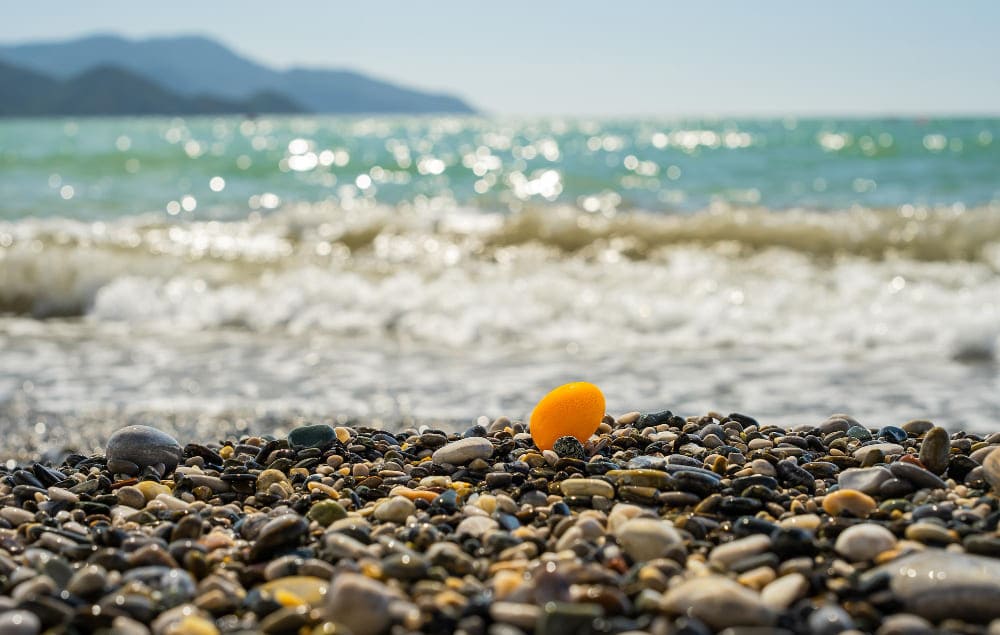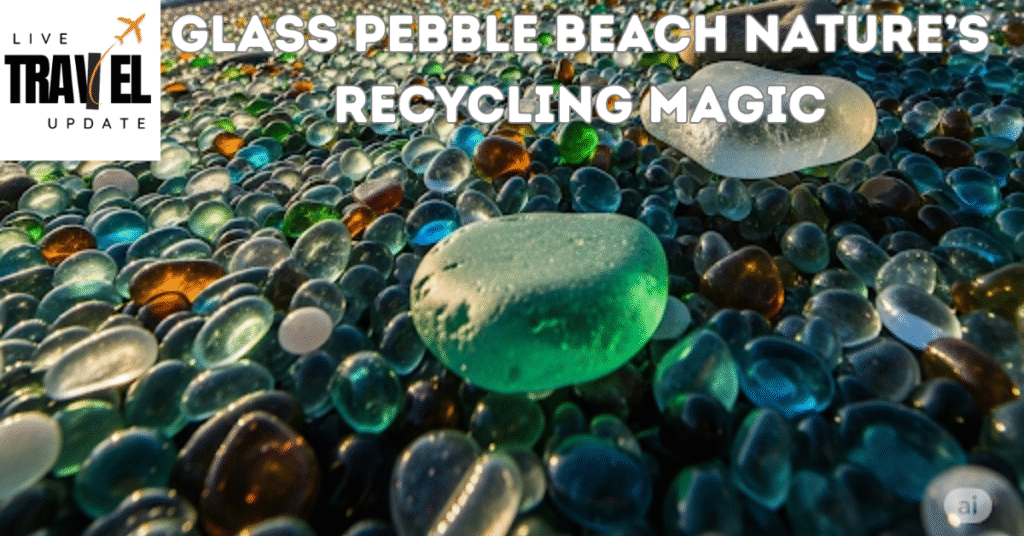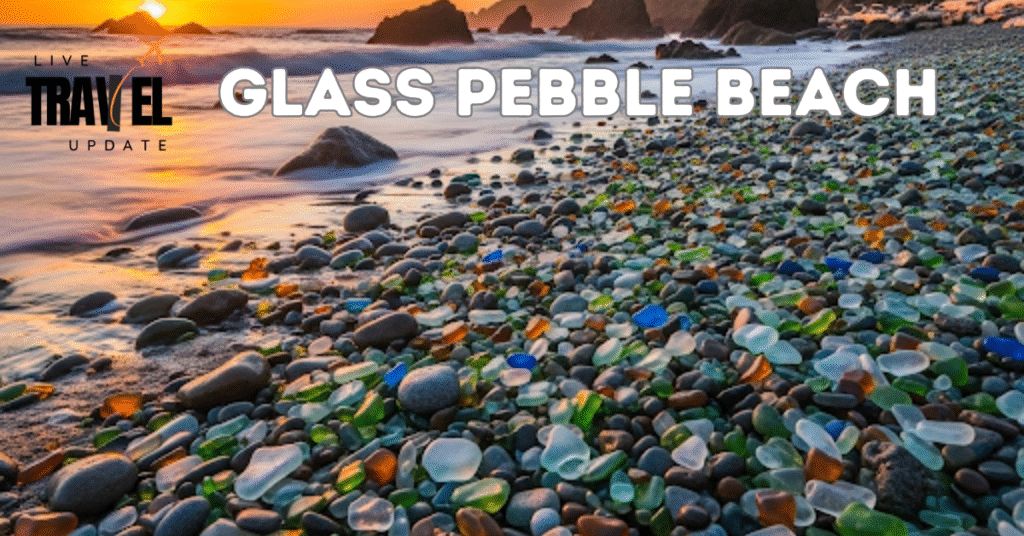Glass Pebble Beach Fort Bragg’s Colorful Shoreline Gem

1. What is Glass Pebble Beach?
Glass Pebble Beach isn’t just a beach; it’s a symphony of nature and human history. Imagine a shoreline carpeted with smooth, jewel-toned glass pebbles that glimmer under the sun. Located in Fort Bragg, California, this unique destination was born from decades of ocean waves transforming discarded trash into breathtaking treasures

Glass Pebble Beach is a natural marvel where the ocean has transformed discarded glass into smooth, colorful gems.
These glass pieces, once considered trash, are polished by waves, sand, and time to become beautiful pebbles that now cover the shores of unique coastal locations.
With vibrant blues, greens, reds, and ambers scattered across the shoreline, Glass Pebble Beach is a rare example of how nature can reclaim human waste and turn it into beauty.
The Unforgettable History of Glass Pebble Beach
The Fort Bragg Sea Glass Story
In Fort Bragg, California, the coastline was once used as a dumping ground for household waste. Over the decades, the ocean worked its magic, transforming broken bottles and glassware into gleaming pebbles.
Today, Glass Beach at Fort Bragg is protected as part of MacKerricher State Park, drawing thousands of visitors who come to witness this accidental work of art.
The Kauai Sea Glass Story
On the Hawaiian island of Kauai, glass pebbles are found along secluded shores, shaped by volcanic sand and strong Pacific currents. Kauai’s sea glass is often embedded with unique hues due to the island’s mix of imported goods and native materials.
The blend of natural surroundings and colorful glass makes it a picturesque location for beachcombers.
The Vladivostok Sea Glass Story
Russia’s Ussuri Bay near Vladivostok was a former dump site for old vodka bottles and porcelain. Harsh weather and icy waves smoothed the shards into bright, frosty stones that now blanket the shore.
Once a restricted area, it has now become a tourist attraction and an example of nature’s slow and quiet artistry.
The Davenport Sea Glass Story
Near Santa Cruz in California, the town of Davenport has its own slice of sea glass history. Unique colors like cobalt blue and vibrant reds are found here, mainly due to a nearby art glass factory that operated decades ago. These rare pebbles are prized by collectors and photographers alike.
The Ireland Island Sea Glass Story
Ireland Island in Bermuda has beaches where remnants of naval operations and local life have been reshaped by the Atlantic. This island’s isolated position has preserved its glass pebbles remarkably well. Visitors are often stunned by the pastel-toned sea glass that contrasts sharply with white sand and turquoise water.
The Port Townsend Sea Glass Story
Port Townsend, Washington, a historic port town, has hidden beaches where sea glass is found in abundance. The cool waters of the Pacific Northwest have shaped the glass more slowly, resulting in well-frosted, perfectly rounded pebbles that tell tales of maritime heritage and coastal trade.
Nature’s Recycling Magic
The transformation of broken glass into smooth sea pebbles is a fascinating example of nature’s ability to recycle. This process can take 20 to 50 years. Constant tumbling by ocean waves, grinding by sand, and exposure to the elements give the glass its rounded edges and frosted finish.
Each piece is unique, both in shape and color, reflecting its original form and the journey it took to become a natural gem.

Where is Glass Pebble Beach Located?
Glass Pebble Beaches exist in several parts of the world, but the most renowned is in Fort Bragg, California. Others include Kauai in Hawaii, Ussuri Bay in Russia, Davenport and Port Townsend in the United States, and Ireland Island in Bermuda. These beaches are often located where glass dumping historically occurred, giving nature the raw materials to work with over decades.
Why Fort Bragg is the Crown Jewel of Glass Beaches
Glass Pebble Beach in Fort Bragg is considered the most iconic due to its dense concentration of sea glass and accessibility. As part of a protected state park, the beach remains well-preserved.
Unlike other locations, Fort Bragg has infrastructure to support tourism, interpretive signs explaining its history, and clear pathways leading to the beach. The combination of preservation, beauty, and ease of access makes it a must-visit destination.
Ethical Visiting Guide Respecting Glass Pebble Beach
Visitors must understand that collecting sea glass, especially from protected beaches like Fort Bragg, is discouraged or even illegal. The beauty of these beaches lies in their abundance of glass, which is quickly diminished if every visitor takes a piece.
Stay on marked trails, avoid disturbing natural formations, and educate others about preservation. Taking photos, not pebbles, helps keep the beach beautiful for all.
Photography Secrets of Glass Pebble Beach
For stunning photos, visit during golden hours just after sunrise or before sunset. Use a macro lens to capture the intricate details of the glass pebbles. Wet glass pebbles shine more vividly, so try shooting just after a wave retreats.
Overcast days reduce glare and bring out the natural hues of the glass. Avoid harsh noon light, which flattens colors.
Beyond the Glass Fort Bragg’s Hidden Gems
Aside from Glass Pebble Beach, Fort Bragg offers botanical gardens, cliffside trails, tide pools, and a historic downtown with local art galleries and seafood eateries.
The Skunk Train ride through redwood forests and the Noyo Harbor kayak tours are must-do activities. Make it a full-day or weekend trip to explore this coastal treasure.
Protecting Glass Pebble Beach from Tourists and Time
Conservation efforts are ongoing, but they need the support of responsible tourism. Educational signs, ranger-led tours, and community clean-ups help maintain the natural charm.
Encourage sustainable practices like packing out trash, reporting damage, and supporting local initiatives. The more we understand its value, the better we can preserve this one-of-a-kind beach.
My Glass Pebble Beach Adventure Where Trash Became Treasure
Standing on the pebbled shore of Glass Pebble Beach was surreal. Each step crunched softly over smooth, multicolored gems. I picked up a deep blue piece, only to place it back, realizing this treasure wasn’t mine to take.
Watching kids marvel at the shiny stones and couples photographing the view reminded me that beauty can come from the unlikeliest places. It’s a symbol of redemption – where human error meets nature’s patient healing.

12. FAQs
Where is Glass Pebble Beach?
Fort Bragg, California, is a well-known location.
Can I take glass pebbles home?
No, especially not from protected areas. It’s best to leave them for others to enjoy.
Why is the glass so colorful?
The colors come from different types of bottles and ceramics, tumbled and weathered by the sea.
Is it safe for kids?
Yes, but always supervise young children around waves and sharp rocks.
Are dogs allowed at the beach?
Yes, in many areas on a leash, but check local regulations.
When did the dumping stop?
Most dumping ended by the 1960s when environmental awareness grew.
How long should I spend here?
A couple of hours is ideal, but a half-day allows time for exploring nearby spots.
Is there parking nearby?
Yes, Fort Bragg Glass Beach has designated parking areas.
Is the area wheelchair accessible?
Some viewing areas are available, but direct beach access can be challenging.
Can I swim at Glass Pebble Beach?
Swimming is not recommended due to rocks and tides.
Where is Glass Pebble Beach?
Fort Bragg, California, within MacKerricher State Park.
Can I take glass pebbles home?
No collecting is illegal to preserve this natural wonder.
Why is the glass so colorful?
Decades of wave action polished discarded bottles into smooth gems.
Is it safe for kids?
Yes! Pebbles are rounded and soft, perfect for gentle exploration.
Are dogs allowed?
Leashed pets are welcome on designated trails.
When did dumping stop?
1967; cleanup began in the 1990s.
How long do I spend here?
Plan 2–3 hours for photos, tide pools, and sunsets.
Nearest parking?
Free lots off Glass Beach Drive (fills early; arrive by 9 AM).
Wheelchair accessible?
Partially packed sand paths near cliffs; rocky sections require caution.
13. Conclusion:
Glass Pebble Beach is a testament to nature’s power to heal and create beauty. By visiting responsibly, you protect this sparkling legacy for future generations. Whether you’re a photographer, history buff, or eco-traveller, Fort Bragg’s jewel offers a rare blend of wonder and wisdom. Plan your travel today!


One Comment